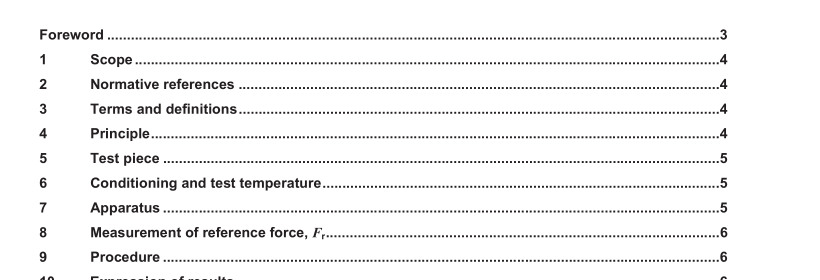EN 14808:2005 – Surfaces for sports areas – Determination of shock absorption

5 Test piece For area-elastic and combined-elastic sports surfaces, the test piece shall be a sample of the complete surfacing system measuring 3,5 m by 3,5 m, assembled and installed in accordance with the manufacturer’s stated method, on a substrate complying with the manufacturer’s requirements. For point-elastic and mixed-elastic sports surfaces, the test piece shall be a piece of the surface of minimum size 1,0 m by 1,0 m, in combination with the supporting layers to be used in service and using the recommended method of attachment in accordance with the manufacturer’s instructions. Laboratory test pieces of either synthetic turf or textile materials shall be prepared in accordance with EN 12229.
6 Conditioning and test temperature For tests in the laboratory, condition the test piece for a minimum of 40 h at a temperature of (23 ± 2) °C. Tests on site shall be carried out at the prevailing ambient temperature and humidity, which shall be recorded and reported.
7 Apparatus
7.1.1 The principle of the apparatus is shown in Figure 1 and consists of the components specified in 7.1.2 to 7.1.10.
7.1.2 Falling weight having a mass of (20 ± 0,1) kg with a hardened striking surface guided so that it is allowed to fall smoothly and vertically with minimum friction.
7.1.3 Spiral spring, having a diameter of (69 ± 1) mm, whose characteristic, when mounted in the assembly described below, is linear with a spring rate of (2 000 ± 60) N/mm over the range 0,1 kN to 7,5 kN with a hardened upper plate. The spring should have three or more coaxial coils which shall be rigidly fixed together at their ends. This may be achieved, for instance, by milling the spring from a single piece of steel.
7.1.4 Adjustable supporting feet, at least 250 mm from the point of application of the load for a point elastic sports surface and at least 600 mm from the point of application of the load for an area elastic sports surface.
7.1.5 Steel base plate, having a lower side rounded to a radius of 500 mm; an edge radius of 1 mm, a diameter (70,0 ± 0,1) mm and a minimum thickness of 10 mm. 7.1.6 Metal guiding tube having an internal diameter of (71,0 ± 0,1) mm.
7.1.7 Testing foot, consisting of the steel base plate, force sensing device, spring and the upper plate (minimum thickness 20 mm, measured at the centre of the plate) together, guided in the guiding tube. The total mass of the testing foot (without guiding tube) shall be (3,0 ± 0,3) kg.
7.1.8 Means of supporting the weight, allowing it to be set to the drop height with an uncertainty no greater than ± 0,25 mm.
7.1.9 Means of conditioning and recording the signal from the force sensing device and the sensors and a means of displaying the record. The channel frequency class of the conditioning amplifier, in accordance with ISO 6487, shall be ≥ 1 kHz. The conditioning amplifier shall be followed by or shall incorporate a low-pass filter having a 2 nd order Butterworth characteristic with a -3 dB frequency of 120 Hz. Filtration may be implemented in hardware or software. The response of the system at any given frequency shall be within ± 0,5 dB of the expected response, calculated on the basis of the Butterworth function.
EN 14808:2005 – Surfaces for sports areas – Determination of shock absorption